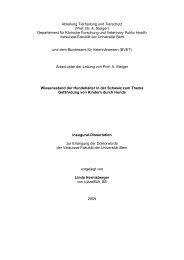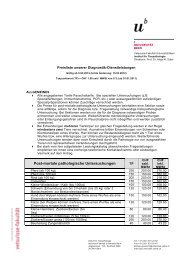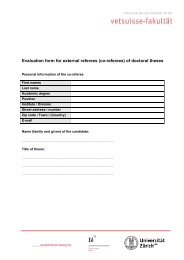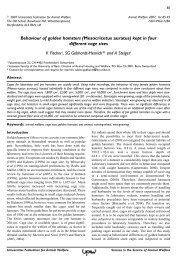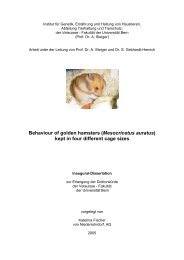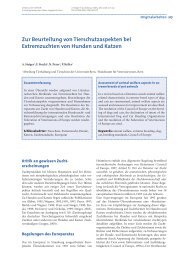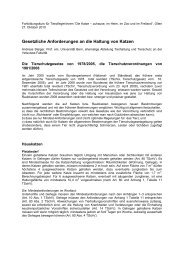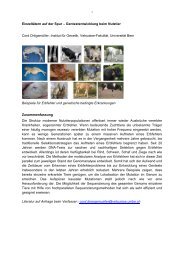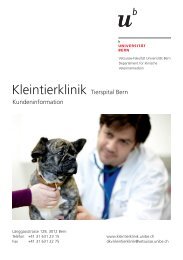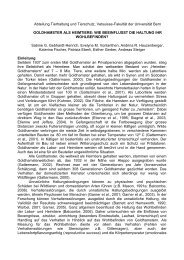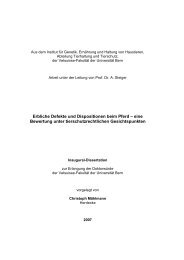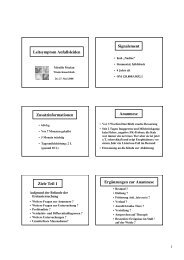Lifespan and Causes of Death in the Irish Wolfhound - Vetsuisse ...
Lifespan and Causes of Death in the Irish Wolfhound - Vetsuisse ...
Lifespan and Causes of Death in the Irish Wolfhound - Vetsuisse ...
You also want an ePaper? Increase the reach of your titles
YUMPU automatically turns print PDFs into web optimized ePapers that Google loves.
f<strong>in</strong>d<strong>in</strong>gs <strong>of</strong> <strong>the</strong> study at h<strong>and</strong> are identical to those derived from <strong>the</strong> data <strong>of</strong> Bernardi<br />
(1986) <strong>and</strong> Prokopenko (1998) as described <strong>in</strong> chapters 5.1.5 <strong>and</strong> 6.2.4, provid<strong>in</strong>g<br />
considerable support for this hypo<strong>the</strong>sis. Unfortunately, no sufficient data on which<br />
types <strong>of</strong> cancer account for this phenomenon were available.<br />
Castration showed a considerable lifespan benefit <strong>in</strong> female <strong>Irish</strong> <strong>Wolfhound</strong>s <strong>in</strong> this<br />
study, which is consistent with what is generally accepted <strong>in</strong> <strong>the</strong> literature. In male<br />
<strong>Irish</strong> <strong>Wolfhound</strong>s, however, a non-significant decrease <strong>in</strong> life expectancy, as well as a<br />
significant <strong>in</strong>crease <strong>in</strong> Osteosarcoma risk was found <strong>in</strong> castrated animals. This<br />
mirrors f<strong>in</strong>d<strong>in</strong>gs <strong>in</strong> o<strong>the</strong>r studies, where castration has been associated with an<br />
<strong>in</strong>crease <strong>in</strong> osteosarcoma risk (Ru, Terrac<strong>in</strong>i et al. 1998; Cooley, Beranek et al.<br />
2002). However, no such risk <strong>in</strong>crease was found for castrated female <strong>Irish</strong><br />
<strong>Wolfhound</strong>s <strong>in</strong> <strong>the</strong> study at h<strong>and</strong> as opposed to <strong>the</strong> two quoted studies.<br />
It is possible that <strong>the</strong> <strong>in</strong>crease <strong>in</strong> OS risk <strong>in</strong> castrated males may be partially<br />
mediated through a longer growth period <strong>in</strong> males that underwent early castration.<br />
However, o<strong>the</strong>r hormone-mediated effects are likely to also play a role <strong>in</strong> this context.<br />
Given that nei<strong>the</strong>r a lifespan benefit nor a decrease <strong>in</strong> any particular cause <strong>of</strong> death<br />
associated with male castration could be demonstrated <strong>in</strong> <strong>the</strong> study at h<strong>and</strong>, it seems<br />
advisable not to rout<strong>in</strong>ely subject male <strong>Irish</strong> <strong>Wolfhound</strong>s to <strong>the</strong> procedure. If <strong>the</strong><br />
owner <strong>in</strong>sists on <strong>the</strong> operation, it should at least be postponed until after <strong>the</strong> end <strong>of</strong><br />
<strong>the</strong> animal's growth period.<br />
7.1.5 Development <strong>of</strong> <strong>Lifespan</strong> Over Time<br />
As shown <strong>in</strong> chapter 6.2.6, <strong>the</strong>re was a highly significant dim<strong>in</strong>ution <strong>of</strong> life expectancy<br />
<strong>in</strong> dogs born s<strong>in</strong>ce <strong>the</strong> 1960s. Fur<strong>the</strong>rmore, although lifespan data from before this<br />
period are scarce <strong>in</strong> <strong>the</strong> database used for this study, o<strong>the</strong>r results (Comfort 1956)<br />
suggest that <strong>the</strong>re seems to be a phase <strong>of</strong> <strong>in</strong>creas<strong>in</strong>g lifespan, <strong>the</strong>n a po<strong>in</strong>t when a<br />
maximal lifespan was reached <strong>in</strong> dogs born <strong>in</strong> <strong>the</strong> 1960s, followed by a period where<br />
it dropped aga<strong>in</strong>, to <strong>the</strong> po<strong>in</strong>t where life expectancy <strong>of</strong> <strong>Irish</strong> <strong>Wolfhound</strong>s born 1990-<br />
1993 was decreased by roughly 1½ years as compared to <strong>the</strong>ir ancestors born<br />
dur<strong>in</strong>g <strong>the</strong> 1960s.<br />
The reasons for this development are difficult to ascerta<strong>in</strong>. Obviously, <strong>the</strong> <strong>in</strong>creas<strong>in</strong>g<br />
possibilities <strong>of</strong> can<strong>in</strong>e veter<strong>in</strong>ary health care that became available <strong>in</strong> <strong>the</strong> years<br />
follow<strong>in</strong>g 1960 are a possible c<strong>and</strong>idate to expla<strong>in</strong> <strong>the</strong> <strong>in</strong>crease <strong>in</strong> lifespan dur<strong>in</strong>g this<br />
period – <strong>the</strong> <strong>in</strong>troduction <strong>of</strong> effective veter<strong>in</strong>ary vacc<strong>in</strong>ation programs <strong>in</strong> this decade <strong>in</strong><br />
particular has probably played a key role, as may be <strong>the</strong> case with <strong>the</strong> wider<br />
availability <strong>of</strong> antibiotic <strong>and</strong> antiparasitic drugs. However, this does not expla<strong>in</strong> why<br />
lifespan subsequently started to drop aga<strong>in</strong> despite <strong>the</strong> fact that <strong>the</strong> quality <strong>of</strong><br />
available veter<strong>in</strong>ary care cont<strong>in</strong>ued to <strong>in</strong>crease.<br />
Natural selection – "survival <strong>of</strong> <strong>the</strong> fittest" – may have <strong>in</strong>fluenced <strong>the</strong> observed<br />
development: Back when veter<strong>in</strong>ary care was more limited <strong>in</strong> its possibilities, <strong>Irish</strong><br />
<strong>Wolfhound</strong>s were subject to selection by <strong>the</strong>ir natural fitness <strong>and</strong> vigour. Even <strong>in</strong> <strong>the</strong><br />
absence <strong>of</strong> conscious selection for health <strong>and</strong> vigour traits, it was less common for<br />
weaker <strong>in</strong>dividuals to be used for breed<strong>in</strong>g, s<strong>in</strong>ce <strong>the</strong>y were elim<strong>in</strong>ated from <strong>the</strong><br />
genepool at an earlier age; most probably due to <strong>in</strong>fectious diseases. This may have<br />
contributed to a selection for vigour as well as cont<strong>in</strong>uous purg<strong>in</strong>g phenomena (see<br />
chapter 7.2.2.3) <strong>in</strong> <strong>the</strong> breed<strong>in</strong>g population, which could <strong>the</strong>n realise its full genetic<br />
93



